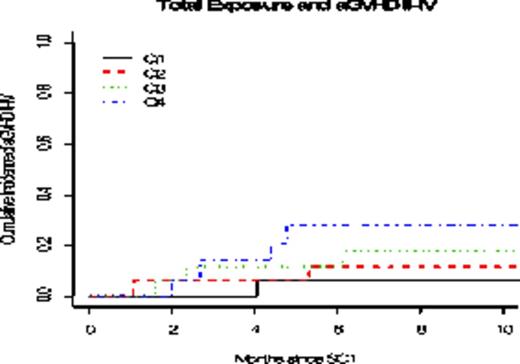Abstract
CD34 selected stem cell transplants (SCT) have shown similar survival rates as unmodified SCT, with lower incidence of acute and chronic graft-versus-host disease (GVHD). A common conditioning regimen for patients with advanced myelodysplastic syndrome (MDS) undergoing CD34 selected SCT is a combination of busulphan, melphalan, fludarabine, and anti- thymocyte globulin (ATG). The ideal area under the curve (AUC) and overall dose intensity of busulphan is unknown in these pts.
We aimed to study the relationship between busulfan AUCs and transplant outcomes in this pt population.
This retrospective analysis included 68 pts with advanced MDS (RAEB-I and higher) who underwent CD34 selected SCT between 2000-2012. Median age was 58.05 yrs (26-73). There were 36 women (52.9%). HCT CI was ³ 3 in 37 pts (54.4%). MDS subtype at diagnosis by WHO criteria was: RA/RCMD-19 (all progressed to RAEB/AML), RAEB-I 20 &RAEB II 29; and by IPSS-R criteria in 65 pts: very low risk-4, low risk-9, intermediate risk-14, high risk-20 & very high risk-18. All pts were conditioned with busulphan IV 0.8 mg/kg dose, melphalan 140 mg/m2, fludarabine 125 mg/m2 & ATG . Thirty-nine pts received 10 doses of busulphan and 29 pts 12 doses. The dose was increased to reduce the relapse rate. Pharmakokinetic studies were done after first busulphan's dose and based on results adjustments were made to achieve a target dose of 1025-1315µM x min. G-CSF mobilized donor peripheral blood stem cells underwent CD34+ selection and depletion of T cells using CliniMACS immunomagnetic selection columns (Milteny Biotec). Donors were HLA matched, 48 (18 related & 30 unrelated) or mismatched unrelated, 20.
The median first-dose busulphan AUC was 1,206 (723-2,180). In 27 pts (39.7%) this was within target range of 1,025-1,315 with 16 pts (23.5%) below and 25 (36.7%) above. The median total busulphan exposure for all pts was 12,822 (9,513-15,754), with 1st quartile range of 9,513-12,181 and 4th quartile range of 13,664-15,754. The median total exposure in the 10 doses group (group 10) was 12,520 (9,513-15,754) and in the 12 doses group (group12) 13,420 (9,860-15493). The 2-years overall survival (OS) was 61.5% (CI 44.5-74.7) in group 10 and 55.2%(35.6-71) in group 12 and 2-years relapse free survival (RFS) was 56.4% (39.6-70.2) in group 10 and 51.7% (32.5-67.9) in group 12. The 2-years cumulative incidence of relapse was 15.4% (CI 3.9-26.9) in group 10 and 13.8% (CI 0.9-26.6) in group 12. The non-relapse (NRM) mortality at 2 years was 28.2% (13.8-42.6) in group 10 and 34.5% (16.7-52.2) in group 12. aGVHD grade II-IV was 12.8% (2.2-23.5) in group 10 vs 23.1% (6.5-39.7%) in group 12. None of these differences were statistically significant.
Further analysis by quartiles showed no differences in OS, RFS, relapse and NRM between the 4 groups. However, grade II-IV acute GVHD was significantly higher in the 4th quartile exposure, 35.6% (8.9-62.3) vs 5.9% (0-17.5), 11.8% (0-27.6) and 17.6% (0-36.4) in the 1st, 2nd and 3rd quartiles (p=0.046) (table 1).
In thishomogenous cohort of pts, total busulphan exposure was only found to be associated with grade II-IV aGVHD, with higher incidence seen in pts who had exposure >13,664. Donor mismatch status was not associated with higher aGVHD in this cohort and therefore can not explain the increased aGVHD seen with higher busulphan exposure. A trend for better transplant outcomes was seen with total exposure of 12,182- 13,663 (2nd and 3rd quartiles); though the differences were not statistically significant. In CD34 selected allo-HSCT for pts with advanced MDS, the intensity of the conditioning has an impact on transplant outcomes and therefore determining the range of busulphan that offers best survival with minimal GVHD has important clinical implications.
Transplant outcomes (cumulative incidence with 95% CI):
| Total exposure . | 6-months CI of aGVHD II-IV . | 2-year CI of Relapse . | 2-year CI NRM . | 2-year CI OS . | 2-year CI RFS . |
|---|---|---|---|---|---|
| Q1: 9,513-12,181, n=17 | 5.9 (0-17.5) | 35.3 (11.6-59) | 23.5 (2.4-44.7) | 52.9 (27.6-73) | 41.1 (18.6-62.6) |
| Q2: 12,181-12,822, n=17 | 11.8 (0-27.6) | 11.8 (0-27.7) | 23.5 (2.6-44.4) | 70.6 (43.1-86.6) | 64.7(37.7-82.3) |
| Q3: 12,823-13,663, n=17 | 17.6 (0-36.4) | 5.9 (0-17.5) | 35.3 (11.7-58.9) | 58.8 (32.5-77.8) | 58.5 (32.5-77.8) |
| Q4: 13,664-15,754 n=17 | 35.6 (8.9-62.3) | 5.9 (0-17.4) | 41.2 (16.8-65.6) | 52.9 (27.6-73) | 52.9 (27.6,-73.0) |
| p value* | overall: 0.185, Q4 vs others: 0.046 | 0.221 | 0.409 | 0.663 | 0.540 |
| Total exposure . | 6-months CI of aGVHD II-IV . | 2-year CI of Relapse . | 2-year CI NRM . | 2-year CI OS . | 2-year CI RFS . |
|---|---|---|---|---|---|
| Q1: 9,513-12,181, n=17 | 5.9 (0-17.5) | 35.3 (11.6-59) | 23.5 (2.4-44.7) | 52.9 (27.6-73) | 41.1 (18.6-62.6) |
| Q2: 12,181-12,822, n=17 | 11.8 (0-27.6) | 11.8 (0-27.7) | 23.5 (2.6-44.4) | 70.6 (43.1-86.6) | 64.7(37.7-82.3) |
| Q3: 12,823-13,663, n=17 | 17.6 (0-36.4) | 5.9 (0-17.5) | 35.3 (11.7-58.9) | 58.8 (32.5-77.8) | 58.5 (32.5-77.8) |
| Q4: 13,664-15,754 n=17 | 35.6 (8.9-62.3) | 5.9 (0-17.4) | 41.2 (16.8-65.6) | 52.9 (27.6-73) | 52.9 (27.6,-73.0) |
| p value* | overall: 0.185, Q4 vs others: 0.046 | 0.221 | 0.409 | 0.663 | 0.540 |
Giralt:SANOFI: Consultancy, Honoraria, Research Funding; CELGENE: Consultancy, Honoraria, Research Funding; AMGEN: Consultancy, Research Funding; JAZZ: Consultancy, Honoraria, Research Funding, Speakers Bureau; TAKEDA: Consultancy, Honoraria, Research Funding.
Author notes
Asterisk with author names denotes non-ASH members.


This feature is available to Subscribers Only
Sign In or Create an Account Close Modal